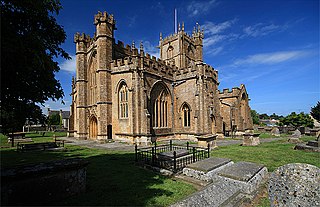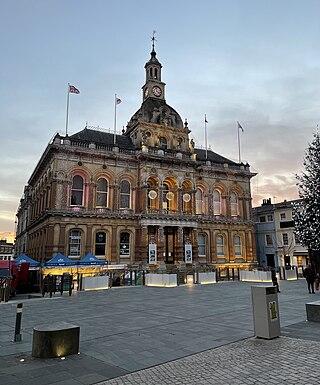
Sherborne is a market town and civil parish in north west Dorset, in South West England. It is sited on the River Yeo, on the edge of the Blackmore Vale, 6 miles east of Yeovil. The parish includes the hamlets of Nether Coombe and Lower Clatcombe. The A30 road, which connects London to Penzance, runs through the town. In the 2011 census the population of Sherborne parish and the two electoral wards was 9,523. 28.7% of the population is aged 65 or older.

Crewkerne is a town and electoral ward in south Somerset, England, 9 miles (14 km) southwest of Yeovil and 7 miles (11 km) east of Chard. The civil parish of West Crewkerne includes the hamlets of Coombe, Woolminstone and Henley, and borders the county of Dorset to the south. The town is on the main headwater of the River Parrett, A30 road and West of England Main Line railway, in modern times the slower route between the capital and the southwest peninsula, having been eclipsed by the Taunton route.

Thorncombe is a village and civil parish in the English county of Dorset. It was historically, until 1844, an exclave of Devon. It lies five miles (8 km) south east of the town of Chard in neighbouring Somerset. Thorncombe is situated close to the borders of both Somerset and Devon. In the 2011 census the population of the civil parish was 687.

George Gillespie was a Scottish theologian.
Coombe is an alternate spelling of combe, a dry valley.

The College of Richard Collyer, formerly called Collyer's School, is a co-educational sixth form college in Horsham, West Sussex, England. The college was rated as being 'good' by Ofsted in 2021.

Lady Manners School is an English secondary school located in Bakewell, a market town in the Peak District National Park, Derbyshire. It was founded on 20 May 1636 by Grace, Lady Manners, who lived at Haddon Hall, the current home of Lord and Lady Edward Manners, and has also in the past been known as the Bakewell Grammar School. It is now a member of the Peak 11 group of secondary schools in the Peak District.

William Draper Best, 1st Baron Wynford, PC, was a British politician and judge. He served as Chief Justice of the Common Pleas from 1824 to 1829.

Philip Henry was an English Nonconformist clergyman and diarist. His son Matthew Henry was a notable commentator on the Bible and also a Presbyterian minister.
Hull Grammar School was a secondary school in Hull, England, founded around 1330 and endowed in 1479 by the prelate John Alcock. In 1988, as part of a restructure by the Local Education Authority, the site was renamed William Gee School. Meanwhile, Hull Grammar School relocated to the old Marist College site on Cottingham Road, becoming a fee paying school in 1989, only to merge with Hull High School in 2005 to form the Hull Collegiate School.

John Woodbridge VI (1613–1696) was an English nonconformist, who emigrated to New England. He had positions on both sides of the Atlantic, until 1663, when he settled permanently in New England.
Lazarus Seaman, was an English clergyman, supporter in the Westminster Assembly of the Presbyterian party, intruded Master of Peterhouse, Cambridge, and nonconformist minister.

The Church of St Bartholomew in Crewkerne, Somerset, England dates from the 15th century and has been designated as a Grade I listed building.

James Mountford Allen was an English architect.
Joshua Bayes (1671–1746) was an English Nonconformist minister.

Pitlochry Church of Scotland is a congregation of the Church of Scotland, a Presbyterian Church. The church building is located in Church Road, Pitlochry, in Perthshire, Scotland. The church today serves the tourist town of Pitlochry in the Tummel valley. The church is a category A listed building.

Hugh Squier (1625-1710) of Petty France, Westminster, was a wealthy merchant best remembered as a generous benefactor to the town of South Molton in Devon, the place of his birth, where in 1684 he founded a "free school".

Bellamy and Hardy was an architectural practice in Lincoln, England, that specialised particularly in the design of public buildings and non-conformist chapels. Pearson Bellamy had established his own architectural practice by 1845 and he entered into a partnership with James Spence Hardy in June 1853. Both partners had previously worked for the Lincoln architect William Adams Nicholson. Hardy was described as "Chief Clerk" to Nicholson. Hardy joined Pearson Bellamy immediately after the sudden death of Nicholson. As all known architectural drawings by the practice are signed Pearson Bellamy, it is likely that Bellamy was the architect and Hardy was the administrator in the practice. The partnership lasted until 1887. Bellamy continued to practise until 1896.

Townsend Cemetery is a cemetery in Crewkerne, Somerset, England. It is owned by Crewkerne Town Council, and jointly run by the Town Council and West Crewkerne Parish Council.
Thomas Lye, or Lee, or Leigh, was an English Nonconformist minister.
















